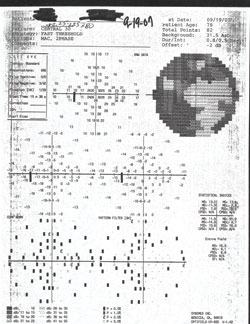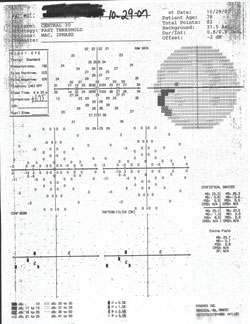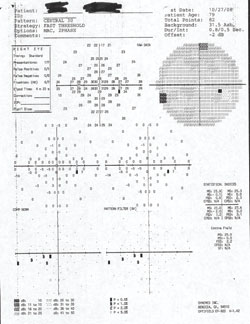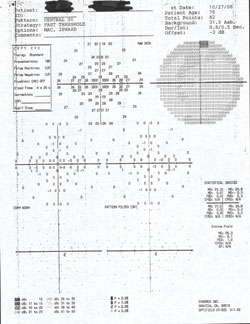Case report: Minocycline use restores visual field in ischemic stroke patient
After 1 week of treatment, the patient’s fields were back to normal.
A 77-year-old white male presented Sept. 13, 2007, with complaints of temporal field loss in his left eye for the last 5 to 6 hours. He also had severe headaches and mental confusion. His wife indicated that while walking, he had been inadvertently hitting the left side of door jams and knocking pictures off the wall.
The patient was being treated for long-standing high blood pressure with Benicar (olmesartan medoxomil, Sankyo) and high cholesterol with Zocor (simvastatin, Merck Sharp & Dohme) 20 mg. He was also taking an aspirin (325 mg) daily. Travatan (travoprost, Alcon) was prescribed in the past for possible normal-tension glaucoma. He was allergic to penicillin and sulfa.
Corrected visual acuity was 20/25 in each eye. Confrontation indicated a significant loss of visual fields to the left in both eyes. His pupils were 3 mm and had normal direct and consensual responses. There was no afferent pupillary defect. IOPs measured 9 mm Hg OD and 12 mm Hg OS. The cup-to-disc ratio was 0.7 OD and 0.35 OS with peripapillary atrophy in both eyes.
|
|
|
|
These fields were taken prior to treatment
with minocycline. Images: Tomsik MD |
|
|
|
|
|
These fields were taken shortly after
treatment. |
|
|
|
|
|
These fields were taken 1 year after
treatment. The field study indicates a tremendous improvement with use of
minocycline. |
|
The maculas were normal, and there was mild arterial attenuation in both eyes. Splinter hemorrhages were noted at the disc margins. The peripheral retinas were within normal limits.
Blood pressure was taken as 194/110 mm Hg. Automated visual field on the first day (Sept. 13, 2007) indicated a left homonymous hemianopia.
The patient was referred to the emergency room for work-up for a cerebral vascular accident. CAT scan and MRA indicated an ischemic problem to the right occipital lobe. The patient was treated with an ace inhibitor (lisinopril) and Plavix (clopidogrel bisulfate, Bristol-Myers Squibb/Sanofi).
On Oct. 2, 2007, the “Good Morning America” talk show had a segment based on an article in the journal Neurology about minocycline. The journal indicated that when ischemic stroke patients were given minocycline, their outcomes could be less severe when administered within 24 hours. Even though it was about 3 weeks post-stroke, minocycline 100 mg twice daily was prescribed for this patient for 5 days.
After a few days of treatment, the patient indicated his vision as well as his cognitive ability had been improving. After taking this drug for a week, his visual fields were essentially back to normal. Minocycline appears to have caused miraculous results in this patient. The progress of the patient can be most appreciated by examining the visual fields.
Different theories exist as to how minocycline works on ischemic strokes. It appears the anti-inflammatory effect, and not the antibiotic effect, of this drug causes the area of ischemia to cool down and be revitalized. In this case, the patient’s visual fields improved, and this enabled him to continue functioning as he did prior to the stroke (such as driving a motor vehicle).
Minocycline crosses the blood-brain barrier better than other tetracycline drugs. Minocycline could possibly be indicated for ischemic optic neuropathy, central retinal artery occlusion, vein occlusion and other conditions.
As an optometrist, prior treatment for this condition was through the use of prisms to move the image so that the patient could perceive it, but now with the use of minocycline, the visual field could be restored.
Reference:
- Lampl Y, Boaz M, Gilad R, et al. Minocycline treatment in acute stroke: An open-label, evaluator-blinded study. Neurology. 2007;69:1404-1410.
- Mark D. Tomsik, OD, and Marlene A. Skulskie, OD, can be reached at 3433 Main St., Moss Point, MS 39563; (228) 475-8641; fax: (228) 475-8691; mdtomsik@bellsouth.net.
- Disclosures: Dr. Tomsik has no direct financial interest in the products mentioned in this article, nor is he a paid consultant for any companies mentioned. Dr. Skulskie has no direct financial interest in the products mentioned in this article, nor is she a paid consultant for any companies mentioned.







